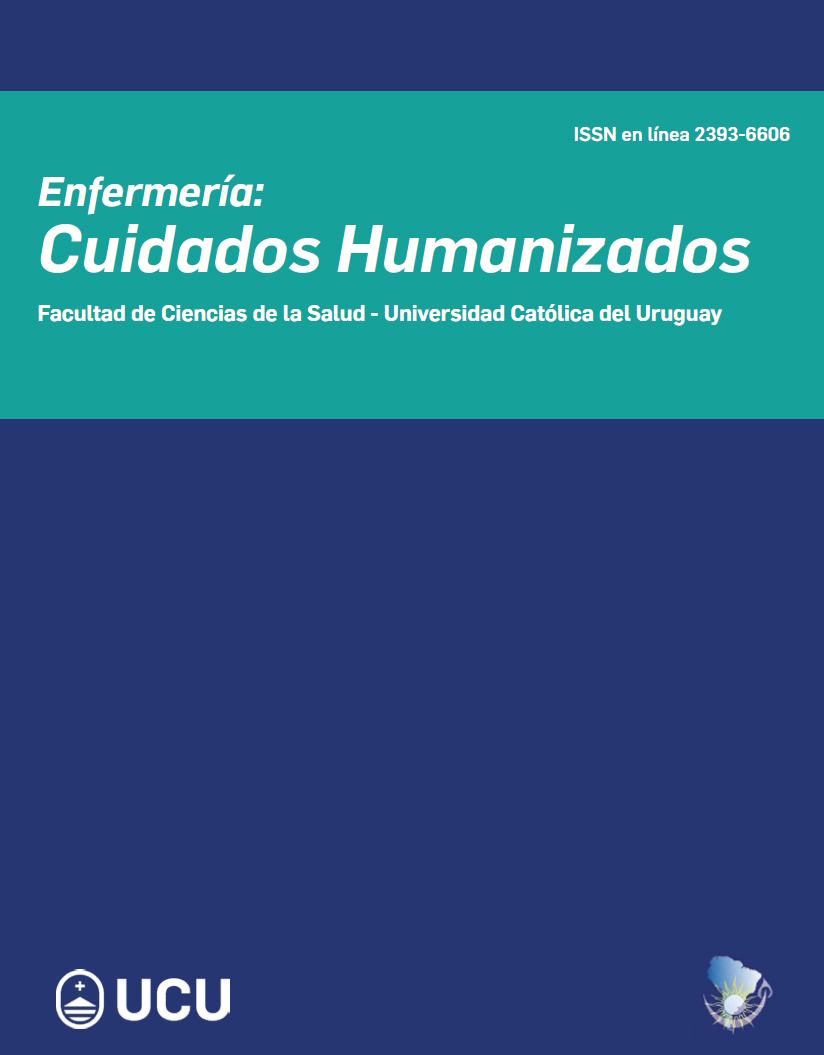Nurses’ Attitudes Towards Hospital and Outpatient Palliative Sedation: A Scoping Review
DOI:
https://doi.org/10.22235/ech.v14i2.4469Keywords:
sedation, nursing, attitudes, ambulatory care, palliative careAbstract
Introduction: The nursing role during palliative sedation focuses on providing comprehensive support to the patient and their family when using this therapy to manage refractory symptoms that do not improve with conventional treatments. Objective: To explore nurses’ stated attitudes toward palliative sedation in hospital and outpatient settings, based on the scientific literature. Methodology: A literature search was conducted in the PubMed, Embase, Scopus, and ScienceDirect databases for articles published between 2018 and 2024, following the Joanna Briggs Institute (JBI) methodology. Results: Fifteen articles were analyzed, and the information was organized into the following categories: specific knowledge; factors related to nurses’ beliefs, values, and perceptions; and aspects concerning emotional support and educational needs. Discussion: Nurses in palliative care units face challenges related to managing suffering and uncertainty before and during the administration of palliative sedation, both in relation to the patient and their family. Attitudes toward this therapy vary depending on the care setting, whether hospital-based or outpatient. Conclusions: Ongoing training and interdisciplinary collaboration are essential to strengthen nursing practice, recognizing palliative sedation as an important intervention to meet the needs of patients and their families. Moreover, knowledge levels regarding this therapy vary according to prior experience and the professional’s work setting.
Downloads
References
1. De Araujo CZS, de Araújo LZS, Nassar Junior AP. Palliative sedation in patients with advanced cancer in a specialized unit in a middle-income country: A retrospective cohort study. Palliative Support Care [Internet]. 2022;20(4):491-495. doi: 10.1017/S1478951521001371
2. Caraceni A, Speranza R, Spoldi E, Ambroset CS, Canestrari S, Marinari M, et al. Palliative Sedation in Terminal Cancer Patients Admitted to Hospice or Home Care Programs: Does the Setting Matter? Results From a National Multicenter Observational Study. J Pain Symptom Manage. 2018;56(1):33-43. doi: 10.1016/j.jpainsymman.2018.03.008
3. World Health Organization. Palliative care [Internet]. WHO; 2020 [citado 2025 abr 9]. Disponible en: https://www.who.int/news-room/fact-sheets/detail/palliative-care
4. Heino L, Stolt M, Haavisto E. The practices of nurses about palliative sedation on palliative care wards: A qualitative study. J Adv Nurs [Internet]. 2022 [citado 2024 jul 26];78(11):3733-3744. doi: 10.1111/jan.15350
5. Piedrafita-Susín AB, Yoldi-Arzoz E, Sánchez-Fernández M, Zuazua-Ros E, Vázquez-Calatayud M. Percepciones, experiencias y conocimientos de las enfermeras sobre cuidados paliativos en las unidades de cuidados intensivos. Enferm Intensiva. 2015;26(4):153-165. doi: 10.1016/j.enfi.2015.06.001
6. Hernández Manzano CM, Angulo Ardoy M, Viloria Jiménez A. Conocimientos de los profesionales de Atención Primaria sobre recursos terapéuticos al final de la vida. Revista Española de Educación Médica [Internet]. 2024 [citado 2024 abr 1];5(2). doi: 10.6018/edumed.600401
7. Bhyan P, Pesce MB, Shrestha U, Goyal A. Palliative Sedation in Patients With Terminal Illness [Internet]. StatPearls Publishing, Treasure Island. 2023. PMID: 29262025 Disponible en: http://europepmc.org/abstract/MED/29262025
8. Peters MD, Godfrey C, McInerney P, Munn Z, Tricco AC, Khalil H. Scoping reviews. En: JBI Manual for Evidence Synthesis. JBI; 2024.
9. Lopez-Cortes OD, Betancourt-Núñez A, Bernal Orozco MF, Vizmanos B. Scoping reviews: una nueva forma de síntesis de la evidencia. Investigación en educación médica [Internet]. 2022 [citado 2024 mar 6];11(44):98-104. doi: 10.22201/fm.20075057e.2022.44.22447
10. Peters MDJ, Marnie C, Tricco AC, Pollock D, Munn Z, Alexander L, et al. Updated methodological guidance for the conduct of scoping reviews. JBI Evid Synth. 2020;18(10):2119-26. doi: 10.11124/JBIES-20-00167
11. Equator Network. Enhancing the QUAlity and Transparency Of health Research [Internet]. UK EQUATOR Centre; 2025 [citado 2024 jun 1]. Disponible en: https://www.equator-network.org/
12. Page MJ, McKenzie JE, Bossuyt PM, Boutron I, Hoffmann TC, Mulrow CD, et al. The PRISMA 2020 statement: an updated guideline for reporting systematic reviews. BMJ. 2021;372. doi: 10.1136/bmj.n71
13. Mengual TE, Chover-Sierra E, Ballestar-Tarín ML, Saus-Ortega C, Gea-Caballero V, Colomer-Pérez N, et al. Knowledge about Palliative Care and Attitudes toward Care of the Dying among Primary Care Nurses in Spain. Healthcare [Internet]. 2023 [citado 2024 jul 26];11(7):1018. doi: 10.3390/healthcare11071018
14. Meesters S, Bazata J, Handtke V, Gehrmann J, Kurkowski S, Klein C, et al. “It’s pretty much flying blind in the home care setting”: A qualitative study on the influence of home care specific circumstances on sedation in specialist palliative home care. Palliat Med [Internet]. 2023 [citado 2024 jul 26];37(1):140-148. doi: 10.1177/02692163221128938
15. Vivat B, Bemand-Qureshi L, Harrington J, Davis S, Stone P. Palliative care specialists in hospice and hospital/community teams predominantly use low doses of sedative medication at the end of life for patient comfort rather than sedation: Findings from focus groups and patient records for I-CAN-CARE. Palliat Med [Internet]. 2019 [citado 2024 jul 27];33(6):578-88. doi: 10.1177/0269216319826007
16. Robijn L, Seymour J, Deliens L, Korfage I, Brown J, Pype P, et al. The involvement of cancer patients in the four stages of decision-making preceding continuous sedation until death: A qualitative study. Palliat Med [Internet]. 2018 [citado 2024 jul 27];32(7):1198-1207. doi: 10.1177/0269216318770342
17. Vieille M, Dany L, Coz P Le, Avon S, Keraval C, Salas S, et al. Perception, Beliefs, and Attitudes Regarding Sedation Practices among Palliative Care Nurses and Physicians: A Qualitative Study. Palliat Med Rep [Internet]. 2021 [citado 2024 jul 27];2(1):160-167. doi: 10.1089/pmr.2021.0022
18. Zuleta‐Benjumea A, Muñoz SM, Vélez MC, Krikorian A. Level of knowledge, emotional impact and perception about the role of nursing professionals concerning palliative sedation. J Clin Nurs [Internet]. 2018 [citado 2024 jul 27];27(21-22):3968-3978. doi: 10.1111/jocn.14582
19. Grüne B, Meesters S, Bausewein C, Schildmann E. Challenges and Strategies Regarding Sedation at the End of Life in Hospitals and Nursing Homes. J Pain Symptom Manage [Internet]. 2022 [citado 2024 jul 27];63(4):530-538. doi: 10.1016/j.jpainsymman.2021.12.012
20. Meesters S, Grüne B, Bausewein C, Schildmann E. «We don’t want to sedate him»: A qualitative interview study on intentions when administering sedative drugs at the end of life in nursing homes and hospitals. BMC Palliat Care [Internet]. 2021 [citado 2024 jul 27];20(1). doi: 10.1186/s12904-021-00832-0
21. Robijn L, Deliens L, Rietjens J, Pype P, Chambaere K, Bowers BJ. Barriers in the Decision Making About and Performance of Continuous Sedation Until Death in Nursing Homes. Gerontologist [Internet]. 2020 [citado 2024 jul 27];60(5):916-925. doi: 10.1093/geront/gnz165
22. Lokker ME, Swart SJ, Rietjens JAC, van Zuylen L, Perez RSGM, van der Heide A. Palliative sedation and moral distress: A qualitative study of nurses. Appl Nurs Res [Internet]. 2018 [citado 2024 jul 27];40:157-161. doi: 10.1016/j.apnr.2018.02.002
23. Santos CG Dos, Faria ME De, Sant’Ana RSE, Bastos RA, Rodrigues JRP de L, Campos CJG, et al. Psychological Fantasies about the Administration of Palliative Sedation to Terminal Cancer Patients: A Qualitative Study of Reports from Brazilian Nurses in a Specialized Hospital. Preprints.org. 2023 [citado 2024 jul 27]. doi: 10.20944/preprints202306.1336.v1
24. Koksvik GH, Richards N, Gerson SM, Materstvedt LJ, Clark D. Medicalisation, suffering and control at the end of life: The interplay of deep continuous palliative sedation and assisted dying. Health (London) [Internet]. 2022 [citado 2024 jul 27];26(4):512-531. doi: 10.1177/1363459320976746
25. Bowers B, Pollock K, Barclay S. Unwelcome memento mori or best clinical practice? Community end of life anticipatory medication prescribing practice: A mixed methods observational study. Palliat Med [Internet]. 2022 [citado 2024 jul 27];36(1):95-104. doi: 10.1177/02692163211043382
26. Guité-Verret A, Boivin J, Hanna AMR, Downar J, Bush SH, Marcoux I, et al. Continuous palliative sedation until death: a qualitative study of palliative care clinicians’ experiences. BMC Palliat Care [Internet]. 2024 [citado 2024 jul 27];23(1):1-11. doi: 10.1186/s12904-024-01426-2
27. Bhyan P, Pesce MB, Shrestha U, Goyal A. Palliative sedation in patients with terminal illness. En: StatPearls [Internet]. Treasure Island, FL: StatPearls Publishing; 2025 [citado 2025 abr 9]. Disponible en: https://www.ncbi.nlm.nih.gov/books/NBK470545/
28. Yamamoto K, Yonekura Y, Nakayama K. Healthcare providers’ perception of advance care planning for patients with critical illnesses in acute-care hospitals: a cross-sectional study. BMC Palliat Care [Internet]. 2022 [citado 2025 abr 9];21(1):7. doi: 10.1186/s12904-021-00900-5
29. Govind N, Ferguson C, Phillips JL, Hickman L. Palliative care interventions and end-of-life care as reported by patients’ post-stroke and their families: a systematic review. European Journal of Cardiovascular Nursing [Internet]. 2023 [citado 2025 abr 9];22(5):445-453. doi: 10.1093/eurjcn/zvac112
30. Chen X, Zhang Y, Arber A, Huo X, Liu J, Sun C, et al. The training effects of a continuing education program on nurses’ knowledge and attitudes to palliative care: a cross sectional study. BMC Palliat Care [Internet]. 2022 [citado 2025 abr 9];21(1):56. doi: 10.1186/s12904-022-00953-0
Downloads
Published
How to Cite
Issue
Section
License
Copyright (c) 2025 Enfermería: Cuidados Humanizados

This work is licensed under a Creative Commons Attribution 4.0 International License.

















